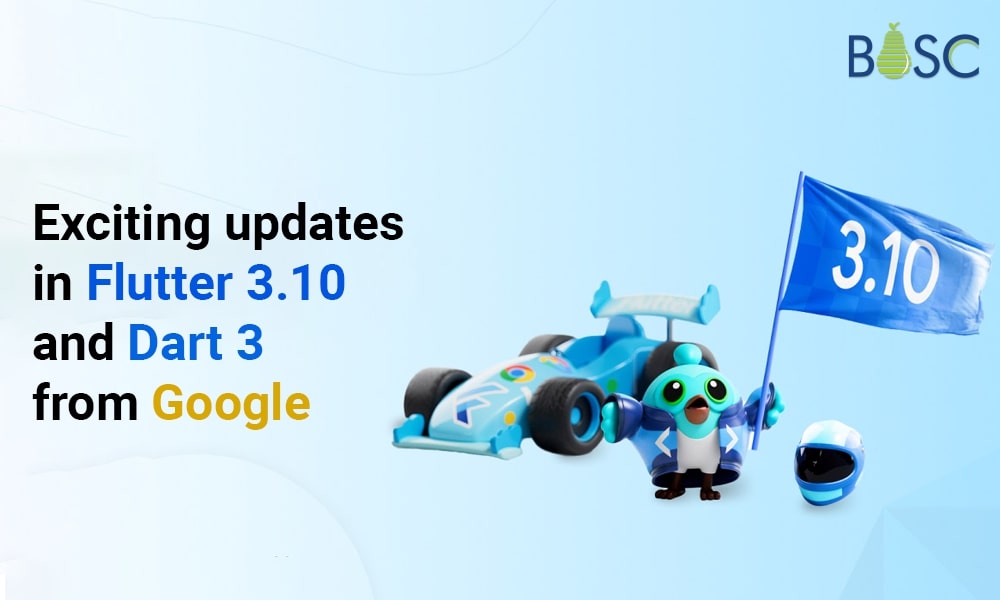Google has recently launched a new version of Flutter 3.10 that is accompanied by significant updates to its programming language, i.e., Dart 3. However, the Flutter 3.10 UI toolkit has a better design and has Mac/ iOS enhancements for desktop, web, or mobile app development. In this, you will find impellers in PROD ready for iOS, Dart 3, and much more with Flutter 3.10. Let’s take a detailed look at the guide to Flutter 3.10.
The most recent version of Flutter, Google’s appreciated UI toolkit, has several interesting updates and improvements that further establish it as a top option for creating visually appealing and effective cross-platform applications.
On May 10, 2023, Google announced the most recent version of Flutter, version 3.10. It includes amazing new features and improvements for desktop, mobile, and online applications, as well as design and macOS/iOS enhancements.
Additionally, Google revealed the revolutionary release of Impeller for iOS, a significant upgrade to the programming language. As well as enforcing null-safe code and previewing WebAssembly (WASM) compilation, Dart 3 adds many web-related improvements that will speed up your Flutter applications by up to three times.
This time, the Google-Flutter team offers several exciting changes and new features, including improved Material 3 widgets, better DevTools for faster app profiling, and support for SLSA Level 1 to handle potential security threats.
The most recent version of Flutter and the most comprehensive UI software development kit from Google, is Flutter 3.10.
As a Flutter app development company, we have seen that Flutter 3.10 has numerous improvements for the web, mobile, graphics, and security, along with Dart 3.
Stay with us as we take you on a brief tour of all these upgrades and additions, so you can get an idea of everything Flutter 3.10 has to offer.
How has Flutter 3.10 changed?
The Dart and Flutter product manager said, “With 100% null safety in Dart, we have a sound type system.” He said, “You can believe that if a type indicates a value isn’t null, then it never can be null. This prevents specific types of programming problems, such as null pointer exceptions. Additionally, it enables code optimization that would not be possible without null safety in our compilers and runtimes.
That’s excellent news for Flutter developers, right?
Learn about all the latest upgrades and features of Flutter 3.10 right now.
- Enhances DevTools
- Support for SLSA Level 1
- Dart 3
- Production-ready Impeller for iOS
- Enhanced version in Flutter app development
Introduction of Dart 3
Flutter 3.10 has introduced a great addition to its very popular programming language, Dart 3. The most significant improvement in Dart 3 is the total removal of the non-null-secure code that assures you to give a secure and error-free experience in its 100% safe language and eliminates the usual bugs of nullable languages. Also, Dart 3 adds several language improvements, like introducing patterns. Hence, this capability makes it very easy to work with structured data.
(String, int) userInfo(Map<String, dynamic> json)
{
return (json['name'] as String, json['height'] as int);
}
In the above example, there is no requirement to make the particular class for that reason or to encapsulate various values inside a collection.
In addition, the new class modifiers like sealed class and interface class give increased capabilities and modify the switched statement, which gives a systematic breakdown of the structured patterns.
SLSA
Security plays a crucial role while working with open-source code, as this is being kept in mind by the Flutter development team while launching the new Flutter 3.10 version.
Additionally, Flutter 3.10 supports Level 1 of the Supply Chain Levels for Software Artifacts (SLSA). However, this integration enables build scripts to work and execute on trusted platforms. Also, it gives many security features, which include:
1. Scripted Build Process:
Automated builds on trustworthy platforms are now possible thanks to Flutter build scripts. Because artifact tampering is strictly prohibited, building on protected architecture promotes supply chain security.
2. Multi-party Approval with Audit Logging:
Workflows for Flutter releases can only go live with multiple engineers’ approval. Auditable log files are produced for each execution. These modifications ensure that the source code and the artifacts created concurrently cannot be changed.
3. Provenance:
This shows that reputable sources made the framework release artifacts with expected contents. Links are provided to see and verify provenance on the SDK archive for each version.
The team can also get closer to SLSA L2 and L3 compliance thanks to this work. These two levels are dedicated to protecting artifacts both during and after development.
These actions have been implemented in response to recent security issues and vulnerabilities discovered in other open-source projects, such as the NPM ecosystem.In order to increase the ecosystem’s dependability and resilience for developers and end users, the Flutter team is actively enhancing its security.
Enhanced Version of Flutter for Web
There is excellent news if you have used Flutter to create Windows applications.
Significant improvements have been made in Flutter for the web application loading performance.
It is surprising that CanvasKit, the largest Flutter for the web component, has substantially decreased and is now only one-third of its prior size.
You can also do away with unnecessary fonts to lighten the overall weight. Full support for swiftly incorporating pure HTML components into the application is now available with Flutter 3.10.Adding fragment shader capability also allows programmers to create stunning visual effects using well-known Dart code.
This demands that languages with garbage collection, like Flutter, be accepted as part of the standard. Initial testing has already revealed a three-fold increase in performance. When WASM is eventually made public, this exciting achievement has huge promise for web applications created using Flutter.
New Material 3 Widgets
Flutter 3.10, the most recent version, has improved support for Material 3. You can use it to make color schemes based on an image or a base color. Several widgets, including DropdownMenu, NavigationDrawer, TabBar, SnackBar, AppBar, and many more, have undergone major enhancements thanks to Material Design components.
Navigation Drawer
The Flutter team has also developed improved support for iOS and macOS. By using this, users may access the spell-checking functionality of Apple within editable text widgets, and a new checkbox and radio button design that matches Cupertino aesthetics is also provided. Additionally, other animation advancements are exclusive to Apple systems.
Refining Cupertino Animations
This Flutter version now supports wireless debugging straight to iPhones and iPads while considering Apple devices. However, Xcode was the only application that previously had this functionality.
You may learn more on Material 3 official website.
Enhancements of DevTools
In this Flutter 3.10 version, the development tools have also undergone some upgrades that make it easier for engineers to evaluate and improve the performance of their projects.
New features and functionalities have also been included to the memory page. The addition of the Diff tool makes it possible to compare memory utilization before and after particular interactions to assess the effects of those interactions. Additionally, improvements have streamlined heap exploration through the console.
By incorporating Material 3 widgets, boosting usability, and adhering to current design guidelines, the DevTools user interface has been improved.
The open-source program Perfetto has also replaced the outdated trace viewer. Perfetto excels in managing large datasets and adds features like pinning threads of interest, dragging and selecting multiple timeline events, and using SQL queries to retrieve specific timeline data.
Production-ready Impeller for iOS
With the launch of Flutter 3.10, Impeller has replaced Skia. It has taken over as iOS’s major rendering engine. The hard shader compilation difficulties that led to janky animations and a bad visual experience are fixed with this new rendering engine, which improves animation performance.
To avoid the necessity of shared compilation during graphics rendering, Impeller uses a tessellation algorithm.
Impeller produces a wide range of forms and colors on the screen smoothly and at a high framerate by utilizing the state-of-the-art capabilities of next-generation GPUs. It has been painstakingly created from the ground up to meet Flutter’s demands specifically.
With Flutter 3.10, Impeller is the default rendering engine in all iOS apps. The Flutter team, who have also highlighted their ongoing efforts in this respect, has stated that a preview version of Impeller for Android is also planned for upcoming releases.
You can find installation instructions for the most recent version of Flutter 3.10 at docs.dev.Flutter and those resources for the Dart SDK at dart.dev.
Dart 3’s stable release is now available, including three significant upgrades:
- 100% guaranteed null safety increases efficiency, enables reduced compiled output, and prevents runtime issues caused by nulls. Null safety is supported by 99% of the 1,000 Dart packages the dev package management currently supports.
- Modern programming uses new language features to allow abstract data types, pattern matching, destructuring, and structured data with records.
- Class modifiers are a “power user” feature that lets package owners describe an API’s capabilities in greater detail.

Conclusion
Google’s main objective for Flutter is to offer five key features: beauty, where each pixel on the screen is controlled; speed, made possible by hardware-accelerated graphics; productivity, where workloads are supported by hot reload and dev tools; portability, where a single shared code base is used for multiple platforms; and universal availability, made possible by being free and open-source.
The front-end development tools that Flutter has developed go beyond this, though. The Google team and the entire Flutter community have done an outstanding job of easing the development process and improving it with frequent upgrades.
As a well-known Flutter app development business, we are thrilled with Flutter 3.10 because it offers us many advantages. This is your chance to update your application to Flutter 3.10, the most recent version, and begin your app development project. Therefore, we can assist you if you want to learn more about the new Flutter version or need assistance creating cross-platform applications. Connect with us and let us know what your project requirements are.
Frequently Asked Questions (FAQs)
1. What distinguishes Flutter 2 from Flutter 3?
Flutter 3 can contribute at a frame rate of 120 Hz, another new feature that sets it apart from Flutter 2. On these machines, Flutter 2 ran at a 60 Hz pace. Users will therefore benefit from an animation experience that runs more smoothly.
2. Why Is Flutter 3.0 a requirement?
The framework now offers a more streamlined and consistent experience across Windows, Mac, and Linux desktop platforms with Flutter 3, which enhances the desktop experience. Flutter 3 will also integrate seamlessly with online platforms, enabling developers to create fast web apps with top-notch user interfaces.
3. Did Google create Flutter for what purpose?
The Google Flutter Software Development Kit (SDK) is a free and open-source tool for creating cross-platform mobile applications. Flutter enables programmers to create high-performance, scalable Android or iOS applications with aesthetically pleasing and useful user interfaces.
Book your appointment now




